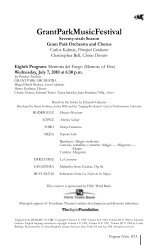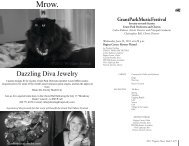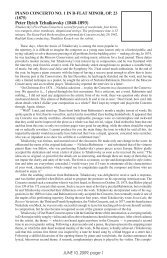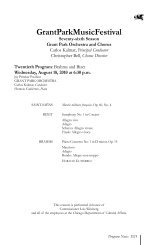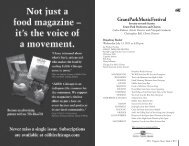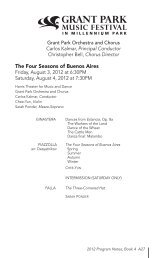rossini's Stabat Mater - The Grant Park Music Festival
rossini's Stabat Mater - The Grant Park Music Festival
rossini's Stabat Mater - The Grant Park Music Festival
You also want an ePaper? Increase the reach of your titles
YUMPU automatically turns print PDFs into web optimized ePapers that Google loves.
<strong>Grant</strong> <strong>Park</strong> Orchestra and Chorus<br />
Carlos Kalmar, Principal Conductor<br />
Christopher Bell, Chorus Director<br />
Rossini’s <strong>Stabat</strong> <strong>Mater</strong><br />
Friday, July 20, 2012 at 6:30PM<br />
Saturday, July 21, 2012 at 7:30PM<br />
Jay Pritzker Pavilion<br />
<strong>Grant</strong> <strong>Park</strong> Orchestra and Chorus<br />
Christopher Bell, Conductor<br />
Jonita Lattimore, Soprano<br />
Jennifer Holloway, Mezzo-Soprano<br />
René Barbera, Tenor<br />
Ryan McKinny, Bass<br />
ROSSINI<br />
LEIGHTON<br />
overture to William Tell<br />
Hymn to Matter<br />
Ryan McKinny<br />
INTERMISSION<br />
ROSSINI<br />
<strong>Stabat</strong> <strong>Mater</strong><br />
Jonita Lattimore, Jennifer Holloway,<br />
René Barbera, Ryan McKinny<br />
2012 Program Notes, Book 3 A29
Friday, July 20 and Saturday, July 21, 2012<br />
Soprano Jonita Lattimore, born on Chicago’s South Side,<br />
performed with the Chicago Children’s Choir before winning a<br />
scholarship to attend the Eastman School of <strong>Music</strong> in Rochester,<br />
New York. She pursued advanced studies at the University of<br />
Illinois at Urbana-Champaign and with Houston Grand Opera’s<br />
Opera Studio and the Ryan Opera Center for American Artists<br />
at Lyric Opera of Chicago. She is currently on the voice faculty<br />
of Roosevelt University’s College of Performing Arts. Ms.<br />
Lattimore has earned awards in the Birgit Nilsson Competition,<br />
Luciano Pavarotti International Voice Competition, George London Foundation<br />
Competition, and in 2000 was included in the Chicago Sun-Times’ list of “25 Most<br />
Intriguing Chicagoans.” Her appearances have taken her from the Bastille Opera in<br />
Paris, Orquestra Metropolitana of Lisbon, Tonkünstler Orchestra of Vienna, Northern<br />
Israel Symphony, Orchestra della Toscana in Italy and Edinburgh <strong>Festival</strong> to the<br />
Orquesta Sinfonica Nacional de Mexico, Weill Recital Hall in Carnegie Hall, Houston<br />
Symphony, Eugene Symphony, Calgary Philharmonic, Houston Grand Opera and Lyric<br />
Opera of Chicago. Since making her <strong>Grant</strong> <strong>Park</strong> <strong>Music</strong> <strong>Festival</strong> debut at the 4th of<br />
July concert in 1998, Jonita Lattimore has returned regularly to perform, including<br />
opening nights of both the Jay Pritzker Pavilion and the Harris <strong>The</strong>ater in 2004 and<br />
the 2009 premiere of Michael Torke’s Plans, commissioned by the <strong>Festival</strong> as part of<br />
the city-wide celebration in honor of the 100th anniversary of Daniel Burnham’s Plan<br />
for Chicago; her most recent <strong>Festival</strong> appearance was in Michael Tippett’s A Child of<br />
Our Time in July 2010.<br />
Ohio-born mezzo-soprano Jennifer Holloway gained<br />
international prominence in 2006 when as an apprentice at<br />
the Santa Fe Opera she took over the leading role of Le Prince<br />
Charmant in Massenet’s Cendrillon opposite Joyce DiDonato as<br />
Cinderella. Ms. Holloway’s success led to invitations to appear<br />
with leading opera companies, including the Opéra National de<br />
Bordeaux, Teatro Real (Madrid), Maggio <strong>Music</strong>ale (Florence),<br />
Glyndebourne (England), Théâtre du Capitole (Toulouse),<br />
Théâtre du Châtelet (Paris), Teatro Regio (Parma) and New<br />
National <strong>The</strong>atre (Tokyo) overseas, and in the American cities of Dallas, Atlanta,<br />
Minneapolis, Portland, Los Angeles, Pittsburgh, St. Louis, Tulsa and Washington; she<br />
made her Metropolitan Opera debut as Flora in La Traviata during the 2010-2011<br />
season and returns to the Met stage for Don Carlos in 2012-2013. She has appeared<br />
in concert with the orchestras of Jerusalem (for the premiere of Frédéric Chaslin’s Love<br />
and a Question, composed for her), Los Angeles, Atlanta, Chautauqua, Omaha and<br />
the Bard <strong>Music</strong> <strong>Festival</strong>. Ms. Holloway, a graduate of the University of Georgia and<br />
the Manhattan School of <strong>Music</strong>, was a 2006 winner in Fort Worth Opera’s McCammon<br />
Competition and 2005 First Place Winner of the Georgia Region of the Metropolitan<br />
Opera National Council Auditions. She has also received grants from the Licia<br />
Albanese Puccini Foundation, Liederkranz Foundation and Hugo Ross Foundation, as<br />
well as the Anna Case Mackay Award following her participation in Santa Fe Opera’s<br />
Apprentice Singer Program. <strong>The</strong>se performances mark Jennifer Holloway’s <strong>Grant</strong> <strong>Park</strong><br />
<strong>Music</strong> <strong>Festival</strong> debut.<br />
A30 2012 Program Notes, Book 3
Friday, July 20 and Saturday, July 21, 2012<br />
Tenor René Barbera, born in Laredo, Texas and now a<br />
third-year member of Lyric Opera of Chicago’s Patrick G. and<br />
Shirley W. Ryan Opera Center, was awarded First Prize for<br />
Opera, First Prize for Zarzuela and the Audience Prize at Plácido<br />
Domingo’s Operalia competition in 2011 in Moscow, the first<br />
artist to receive all three awards since the competition began<br />
in 1993. Mr. Barbera’s additional honors include the Sullivan<br />
Foundation Award (2011), Men’s First Place in the Union League<br />
Civic & Arts Foundation (2009), Grand Finals Winner in the<br />
Metropolitan National Council Auditions (2008), Grand Prize in the Charles A. Lynam<br />
Vocal Competition (2007), First Place in the Charlotte Opera Guild Vocal Competition<br />
(2006) and First Place in the Heafner/Williams Vocal Competition (2006). During the<br />
2011-2012 season, he was heard with Lyric Opera of Chicago in Lucia di Lammermoor,<br />
Ariadne auf Naxos and <strong>The</strong> Magic Flute; he earlier appeared with Lyric in Carmen, Un<br />
Ballo in Maschera, La Fanciulla del West, Lohengrin and La Cenerentola. Mr. Barbera’s<br />
additional opera credits include Vancouver Opera, Canadian Opera Company and<br />
Opera <strong>The</strong>atre of St. Louis. He has appeared in concert with the Apollo Chorus of<br />
Chicago, Greensboro Symphony and Chicago Philharmonic. Mr. Barbera studied at<br />
the North Carolina School of the Arts and had additional training at the American<br />
Institute of Vocal Arts in Graz, Austria, Vocal Arts Symposium in Colorado Springs and<br />
San Francisco Opera’s Merola Opera Program. René Barbera appeared at the <strong>Grant</strong><br />
<strong>Park</strong> <strong>Music</strong> <strong>Festival</strong>’s Ryan Opera Center programs in 2010 and 2011.<br />
American bass-baritone Ryan McKinny was the first<br />
recipient of the Birgit Nilsson Prize for singing Wagner at<br />
Plácido Domingo’s Operalia Competition, held in 2010 at the<br />
Teatro alla Scala in Milan. In 2007, Mr. McKinny represented<br />
the United States in the BBC Cardiff Singer of the World<br />
Competition, where he was a finalist in the Rosenblatt<br />
Recital Song Prize. He was also a Grand Finalist in the 2007<br />
Metropolitan Opera National Council Auditions and was<br />
featured in the film <strong>The</strong> Audition, recently released by Decca<br />
on DVD. His many opera credits include appearances at New Orleans Opera,<br />
Oper Leipzig, Deutsche Oper Berlin, Canadian Opera Company, Los Angeles<br />
Opera, Houston Grand Opera, Utah Opera, Wolf Trap Opera, <strong>The</strong>ater Basel,<br />
English National Opera, Spoleto <strong>Festival</strong> (Italy), Semperoper Dresden, Hamburg<br />
State Opera, Deutsche Oper am Rhein and Oper Leipzig. Mr. McKinny made his<br />
Metropolitan Opera debut as Lieutenant Ratcliffe in Britten’s Billy Budd during the<br />
2011-2012 season. In concert, he has appeared with the Los Angeles Philharmonic,<br />
Cleveland Orchestra, New York Philharmonic, National Symphony Orchestra and<br />
Aspen <strong>Music</strong> <strong>Festival</strong>, and made his Chicago Symphony Orchestra debut in<br />
2010 in Stravinsky’s Oedipus Rex. Mr. McKinny was heard in a special recital of<br />
Schubert’s Die Winterreise during the Sydney <strong>Festival</strong> that was broadcast on ABC,<br />
Australia’s public radio. He took his professional training at Pasadena City College<br />
in California, the Juilliard School and Houston Grand Opera’s Opera Studio program.<br />
Ryan McKinny makes his <strong>Grant</strong> <strong>Park</strong> <strong>Music</strong> <strong>Festival</strong> debut with these concerts.<br />
2012 Program Notes, Book 3 A31
Friday, July 20 and Saturday, July 21, 2012<br />
Overture to William Tell (1828-1829)<br />
Gioacchino Rossini (1792-1868)<br />
Rossini’s Overture to William Tell is scored for pairs of woodwinds<br />
plus piccolo and English horn, four horns, two trumpets, three<br />
trombones, timpani, percussion and strings. <strong>The</strong> performance<br />
time is 12 minutes. <strong>The</strong> <strong>Grant</strong> <strong>Park</strong> Orchestra first performed this<br />
work on August 1, 1936, with Gladys Welge conducting.<br />
In his later years, Rossini wrote to an aspiring opera composer giving advice about<br />
composing an overture for a new stage work: “Wait until the evening before the<br />
opening. Nothing primes inspiration more than necessity, whether it be the presence<br />
of a copyist waiting for your work or for the prodding of an impresario tearing his hair.<br />
In my time, all the impresarios in Italy were bald at thirty. I composed the overture<br />
to Otello in a little room in the Barbaja palace wherein the baldest and fiercest of<br />
directors had forcibly locked me with a lone plate of spaghetti and the threat that I<br />
would not be allowed to leave the room alive until I had written the last note. I wrote<br />
the overture to La Gazza Ladra the day of the opening in the theater itself, where I was<br />
imprisoned by the director and under the surveillance of four stagehands who were<br />
instructed to throw my original text through the window, page by page, to the copyists<br />
waiting below to transcribe it. In default of pages, they were ordered to throw me out<br />
the window bodily. I composed the overture to Comte Ory while fishing, with my feet<br />
in the water, and in the company of Signor Agnado, who talked of his Spanish fiancée.<br />
<strong>The</strong> overture to William Tell was composed under more or less similar circumstances.”<br />
Even though this admission seems to confirm both Rossini’s lazy procrastination and<br />
his awesome ease of composition, the effort he expended on William Tell seems to<br />
have been rather greater than his words allow.<br />
If there was ever a composer who made a business of writing music, that composer<br />
was Rossini. (Richard Strauss was a close runner-up.) Rossini turned out operas at a<br />
startling rate during the twenty years of his active composing career, sometimes as<br />
many as three or four annually. William Tell was his 38th work in the genre, finished<br />
when he was 37 years old. His previous operas made brilliantly inventive use of the<br />
musico-dramatic formulas and cliches of the late Classical era, and his music proved<br />
to be precisely suited to the taste of audiences throughout Europe — he was the most<br />
popular composer of his time. In 1824, he moved to Paris to become director of the<br />
Théâtre Italien, and there became fully aware of the revolutionary artistic and political<br />
trends that were then gaining prominence. In music, the Romantic movement was<br />
heralded by such works as Carl Maria von Weber’s opera Der Freischütz, first seen in<br />
the French capital in 1824. In politics, republican sympathies were again festering,<br />
and stage works that portrayed the popular struggle against oppression and tyranny<br />
stirred considerable sentiment. Auber’s opera La muette de Portici of 1828, based on<br />
the 17th-century Neapolitan revolt against Spain, not only proved to be a popular<br />
success, but also caught the spirit of the times in both its music and its subject. Rossini<br />
was too closely attuned to public fashion to ignore the changing audience tastes these<br />
pieces portended, and he cast about for a libretto that would keep him abreast of the<br />
latest developments in the musical theater while solidifying his position in Paris.<br />
Schiller’s play William Tell, based on the heroic Swiss struggle against tyranny in<br />
the 14th century, had recently been introduced to Paris in a French translation, and<br />
created much interest. Rossini decided that the drama would make a fine opera (or, at<br />
least, a salable one), and set the minor playwright Jouy to work on the libretto. Jouy<br />
made a botch of the undertaking (“certainly one of the poorest jobs in libretto annals,”<br />
assessed Milton Cross), and Hippolyte Bis and Armand Marrast were called in to put<br />
the book into final shape. Rossini seems to have taken special care to incorporate<br />
2012 Program Notes, Book 3 A33
Friday, July 20 and Saturday, July 21, 2012<br />
the emerging Romantic style into this epic work, as evidenced by its subject matter,<br />
symphonic scope and attention to dramatic and poetic content. <strong>The</strong> French public<br />
followed intently the progress of the new piece through frequent press reports — it<br />
was Rossini’s first opera written exclusively for Paris. From the summer of 1828, when<br />
word of the project first surfaced, through the following spring, when several delays<br />
were reportedly caused by prima donna incapacity (actually, Rossini was withholding<br />
the work’s premiere to press negotiations with the government over a lucrative<br />
contract for future — never realized — operas) until the premiere in August 1829,<br />
William Tell kept Parisian society abuzz. Once the opera finally reached the stage, it<br />
was hailed by critics and musicians, but disappointed the public, who felt that its sixhour<br />
length was more entertainment than a single evening should decently hold. (<strong>The</strong><br />
score was greatly truncated when it was staged in later years.) Whether the new style<br />
of the opera was one which Rossini did not wish to pursue, or whether he was drained<br />
by two decades of constant work, or whether he just wanted to enjoy in leisure the<br />
fortune he had amassed, William Tell was his last opera. During the remaining 39 years<br />
of his life, he did not compose another note for the stage.<br />
<strong>The</strong> Overture to William Tell is essentially a miniature tone poem in several<br />
evocative sections. Peaceful dawn in the Swiss mountains is depicted by the quiet<br />
song of the cello quintet that opens the Overture. <strong>The</strong> following furious music signifies<br />
a violent thunderstorm. <strong>The</strong> subsequent English horn theme portrays the calm after<br />
the tempest and the pastoral beauty of the Swiss countryside. <strong>The</strong> final section is one<br />
of the most famous strains in symphonic music. Rossini originally wrote this theme<br />
seven years earlier in Vienna as a quickstep march for military band, and borrowed it<br />
for William Tell to accompany the triumphant return of the Swiss patriot troops in Act<br />
III and to provide a blazing conclusion to this splendid Overture.<br />
Hymn to Matter (1978)<br />
Kenneth Leighton (1929-1988)<br />
Leighton’s Hymn to Matter is scored for piano, timpani, percussion<br />
and strings. <strong>The</strong> performance time is thirteen minutes. This is the<br />
first performance of the work by the <strong>Grant</strong> <strong>Park</strong> Orchestra.<br />
Kenneth Leighton, one of Britain’s most distinguished<br />
mid-20th-century composers and music teachers, was born in<br />
Wakefield, Yorkshire on October 2, 1929. He studied piano and was a chorister at<br />
Wakefield Cathedral as a boy, and entered Queen’s College, Oxford in 1947 as a<br />
student of classics and music; his principal composition teacher was Bernard Rose.<br />
Upon his graduation, in 1951, he won a Mendelssohn Scholarship, which enabled<br />
him to study in Rome with Goffredo Petrassi. After returning to England the following<br />
year, Leighton taught at the Royal Naval School of <strong>Music</strong> and the University of Leeds<br />
before joining the faculty of the University of Edinburgh in 1955. From 1968 to 1970,<br />
he was University Lecturer in <strong>Music</strong> and Fellow of Worcester College at Oxford; he<br />
earned his doctorate from the university in 1970. In October 1970, he was appointed<br />
Reid Professor of <strong>Music</strong> at the University of Edinburgh, a post he held until his death,<br />
in 1988. Leighton’s distinctions included the Royal Philharmonic Society Prize (1950,<br />
1951), Busoni Prize (1956), Trieste Prize (1965), Bernhard Sprengel Prize (1965) and<br />
Cobbett Medal for distinguished services to chamber music (1968), as well as an<br />
honorary doctorate from the University of St. Andrews (1977).<br />
British musicologist and choir director Richard Cooke wrote that Leighton’s<br />
compositions — an opera (Columba), two symphonies, concertos for piano, organ<br />
and flute, a number of smaller orchestral scores, many sacred and secular vocal<br />
works, chamber music, organ and piano pieces — are characterized by “a compelling<br />
2012 Program Notes, Book 3 A35
Friday, July 20 and Saturday, July 21, 2012<br />
balance of intellectual rigor and romanticism.” His Hymn to Matter, commissioned<br />
in 1978 for the opening of the new Chaplaincy Centre at Edinburgh’s Heriot-Watt<br />
University, one of Scotland’s leading scientific teaching institutions, sets a text by the<br />
controversial French geologist, paleontologist, philosopher and Jesuit priest Pierre<br />
Teilhard de Chardin (1881-1955), whose culminating work, <strong>The</strong> Phenomenon of Man,<br />
describing his view of the unfolding of the cosmos and the evolution of humanity,<br />
was prohibited from publication by the Catholic Church until after his death. Teilhard<br />
wrote Hymn to Matter, which he included in a collection of his mystical and spiritual<br />
writings published posthumously as Hymn of the Universe (1961), in August 1919 to<br />
express a vision he had had of “a world charged with the grandeur of God” when he<br />
was serving as a stretcher-bearer in the World War I battle at Verdun in eastern France,<br />
which claimed some 700,000 lives during its ten horrific months. Leighton’s setting<br />
matches Teilhard’s words with music that suggests both the weight of their subject<br />
and the spirituality of their message.<br />
Blessed be you, harsh matter, barren soil, stubborn rock: you who yield only to<br />
violence, you who force us to work if we would eat.<br />
Blessed be you, perilous matter, violent sea, untameable passion: you who unless we<br />
fetter you will devour us.<br />
Blessed be you, mighty matter, irresistible march of evolution, reality ever new-born;<br />
you who, by constantly shattering our mental categories, force us to go ever<br />
further and further in our pursuit of the truth.<br />
Blessed be you, universal matter, immeasurable time, boundless ether, triple abyss<br />
of stars and atoms and generations: you who by overflowing and dissolving our<br />
narrow standards of measurement reveal to us the dimensions of God.<br />
Without you, without your onslaughts, without your uprootings of us, we should<br />
remain all our lives inert, stagnant, puerile, ignorant both of ourselves and of<br />
God. You who batter us and then dress our wounds, you who resist us and yield<br />
to us, you who wreck and build, you who shackle and liberate, the sap of our<br />
souls, the hand of God, the flesh of Christ: it is you, matter, that I bless.<br />
I bless you and you I acclaim: not as the pontiffs of science or the moralizing preachers<br />
depict you, debased, disfigured — a mass of brute forces and base appetites —<br />
but as you reveal yourself to me today, in your totality and your true nature.<br />
You we acclaim as the inexhaustible potentiality of existence and transformation<br />
wherein the predestined substance germinates and grows.<br />
We acclaim you as the universal power which brings together and unites, through<br />
which the multitudinous monads are bound together and in which they all<br />
converge on the way of the spirit.<br />
<strong>Stabat</strong> <strong>Mater</strong> (1831-1832, 1841)<br />
Gioacchino Rossini<br />
Rossini’s <strong>Stabat</strong> <strong>Mater</strong> is scored for pairs of woodwinds, four horns, two trumpets,<br />
three trombones, timpani and strings. <strong>The</strong> performance time is 60 minutes. <strong>The</strong> <strong>Grant</strong><br />
<strong>Park</strong> Orchestra and Chorus first performed this work on July 23, 1966, with Julius<br />
Rudel conducting. <strong>The</strong> soloists were Martina Arroyo, Beverly Wolff, Michele Molese<br />
and Raymond Michalski.<br />
<strong>The</strong> <strong>Stabat</strong> <strong>Mater</strong> is a 13th-century sequence (i.e., a sacred Latin poem with most<br />
of its lines paired in end-rhyme), usually attributed to the Franciscan monk Jacopone<br />
da Todi, which tells of the piteous anguish of the Mother of Christ as she stands before<br />
the Cross. Though regularly used for personal and communal devotions from the time<br />
of its creation, the <strong>Stabat</strong> <strong>Mater</strong> was not officially accepted into the Roman Catholic<br />
liturgy until 1727. By the early 19th century, the text had been treated by such masters<br />
2012 Program Notes, Book 3 A37
as Josquin, Palestrina, Lassus and Haydn, but the outstanding setting of the verses<br />
was considered at that time to be the one that Giovanni Battista Pergolesi made in<br />
1736. After hearing Pergolesi’s work in Naples in 1820, Gioacchino Rossini vowed<br />
never to put himself in competition with it by composing the same text, but in 1831,<br />
he was prompted to change his mind.<br />
In February 1831, Rossini’s friend, patron and financial advisor, Alexandre-Marie<br />
Aguardo, a naturalized Frenchman of Spanish birth, arranged to take the composer<br />
for a visit to his native land. In Spain, Rossini was feted by King, court and public<br />
alike, but he was most warmly welcomed by Aguardo’s friend Don Francisco Varela,<br />
a cleric, a court counselor and a passionate admirer of his music. Varela longed to<br />
have his very own work in the composer’s hand, and suggested the <strong>Stabat</strong> <strong>Mater</strong> as<br />
an appropriate text. Rossini, who had formally retired from composition two years<br />
before with William Tell, at first demurred, but was eventually cajoled by Aguardo<br />
into supplying this ardent request from such a distinguished source. Sometime after<br />
returning to Paris, Rossini completed six movements of his <strong>Stabat</strong> <strong>Mater</strong> before an<br />
attack of lumbago, exacerbated by his chronic problems with gonorrhea, confined him<br />
to bed for an extended period. Giovanni Tadolini, a native of Bologna, a fellow alumni<br />
with Rossini of that city’s conservatory and then conductor of the Théâtre Italien in Paris,<br />
was enlisted to finish the job. On March 26, 1832, the <strong>Stabat</strong> <strong>Mater</strong> was dispatched to<br />
Varela with an appropriately flowery dedication and the stipulation that the score was<br />
not to be sold or published, but with no indication of the dual authorship of the music.<br />
Varela responded by sending Rossini a magnificent gold snuffbox studded with eight<br />
diamonds. (It is unknown what payment Tadolini received.) Varela reserved his new<br />
work for performance until Good Friday of the following year, when it was given by<br />
more than a hundred singers at the chapel of S. Filippo El Real in Madrid.<br />
Rossini thereafter paid little attention to his <strong>Stabat</strong> <strong>Mater</strong> until 1837, when Varela<br />
died. <strong>The</strong> manuscript for the work was purchased at that time from Varela’s estate<br />
by one Oller Chetard, and four years later came into the possession of the Parisian<br />
publisher Antoine Aulagnier. Aulagnier sought Rossini’s permission to issue the work,<br />
but was summarily refused on the grounds that the <strong>Stabat</strong> <strong>Mater</strong> was intended only<br />
for Varela’s use and that it was essentially incomplete in any case. Rossini drew up a<br />
contract assigning the rights for the score to Eugène-Théodore Troupenas, publisher of<br />
his last four operas, and litigation was joined. <strong>The</strong> ensuing legal battle was decided in<br />
favor of Rossini and Troupenas, which made it incumbent upon the composer to finish<br />
the work that he had abandoned to another hand a decade before. Private readings<br />
of the <strong>Stabat</strong> <strong>Mater</strong> were given in October 1841 at the Parisian salons of the Austrian<br />
pianist Henri Herz and the pianist-composer Pierre-Joseph-Guillaume Zimmerman, and<br />
word of this “new” composition by Rossini, his first substantial creation in a dozen years,<br />
began to circulate among the city’s music lovers. <strong>The</strong> brothers Léon and Marie Escudier,<br />
music publishers and long-standing admirers of Rossini’s compositions, arranged a<br />
public performance for January 7, 1842 at the Salle Ventadour, which proved to be a<br />
spectacular success, though the composer could not attend because he was busy in<br />
Bologna directing the affairs of the Liceo <strong>Music</strong>ale. Rossini himself superintended the<br />
first Italian performances of the <strong>Stabat</strong> <strong>Mater</strong>, however, which took place in Bologna<br />
on March 18, 19 and 20. Gaetano Donizetti, whom he was seeking to install on the<br />
Liceo’s faculty, served as conductor. <strong>The</strong> <strong>Stabat</strong> <strong>Mater</strong> again triumphed, as it did all<br />
across Europe and America — it was performed at least a half-dozen times annually<br />
in Paris after 1842, Michael Costa led some 3,000 singers and instrumentalists in its<br />
presentation in following years at the Crystal Palace in London, Rossini was made a<br />
knight in the recently instituted Order of Merit in the Sciences and Arts by King Friedrich<br />
Wilhelm IV of Prussia in 1842 largely because of its reception, and it was given in such<br />
foreign parts as New York, Philadelphia and Boston within months of its premiere. <strong>The</strong><br />
brilliant success of the <strong>Stabat</strong> <strong>Mater</strong> was mitigated for Rossini only by the death of<br />
A38 2012 Program Notes, Book 3<br />
Friday, July 20 and Saturday, July 21, 2012
Friday, July 20 and Saturday, July 21, 2012<br />
Aguardo in April 1842. <strong>The</strong> work was adapted for use in Rossini’s funeral service at La<br />
Trinité on November 21, 1868, and heard again when his remains were reburied among<br />
those of other heroes of Italian culture at Santa Croce in Florence in May 1887.<br />
Rossini’s <strong>Stabat</strong> <strong>Mater</strong>, though based on a text which limbs the sorrows of the<br />
mother of Christ, encompasses a wide range of emotions in its ten movements, from<br />
stern tragedy to hopeful expectancy. Like Verdi’s Requiem, the <strong>Stabat</strong> <strong>Mater</strong> has been<br />
accused of borrowing too much of the theater to wrap the ancient liturgical words,<br />
though Rossini preferred to think of the music’s long melodic arches and undeniable<br />
drama not as sacrilege but as opera’s offering to the Church. Indeed, in the last four<br />
movements — those which he added in 1841 — Rossini anticipated the brilliance and<br />
emotional weight of the most ambitious passages in Verdi’s Requiem (whose initial<br />
inspiration was, perhaps not coincidentally, Rossini’s death). This intensity of expression<br />
is really quite extraordinary, since Rossini was not overtly religious, though he never fully<br />
outgrew the cultural foundation of Catholic tradition in which he had been raised. When<br />
the priest at his last rites asked the obligatory question about his beliefs, the dying<br />
composer responded, “Would I have been able to compose the <strong>Stabat</strong> <strong>Mater</strong> and the<br />
Petite Messe solennelle if I had not had faith?” From the quiet introspection of its two a<br />
cappella movements to the titanic wailings of its closing fugal Amen, the <strong>Stabat</strong> <strong>Mater</strong><br />
is one of the greatest documents of sacred music of 19th-century Romanticism.<br />
Introduction (Chorus and Soloists)<br />
<strong>Stabat</strong> <strong>Mater</strong> dolorosa<br />
<strong>The</strong> sorrowful Mother stood<br />
juxta crucem lacrimosa<br />
weeping by the cross<br />
dum pendebat Filius.<br />
where her Son was hanging.<br />
Aria (Tenor)<br />
Cujus animam gementem,<br />
Her spirit cried out,<br />
contristatam et dolentem,<br />
full of anguish and sorrow,<br />
pertransivit gladius.<br />
as if pierced by a sword.<br />
O quam tristis et afflicta<br />
o how sad and distressed<br />
fuit illa benedicta<br />
was that blessed Woman,<br />
<strong>Mater</strong> unigeniti!<br />
Mother of the only-begotten Son!<br />
Quae maerebat et dolebat<br />
How She grieved and suffered<br />
et tremebat cum videbat<br />
and trembled as She saw<br />
nati poenas inclyti.<br />
the agonies of her Son.<br />
Duet (Soprano, Mezzo-Soprano)<br />
Quis est homo qui non fleret<br />
What man would not weep<br />
Christi Matrem si videret<br />
to see the Mother of Christ<br />
in tanto supplicio?<br />
in such torment?<br />
Quis non posset contristari<br />
Who would not be saddened<br />
piam matrem contemplari<br />
seeing the pious Mother<br />
dolentem cum Filio?<br />
grieving for her Son?<br />
Aria (Bass)<br />
Pro peccatis suae gentis<br />
For the sins of the world,<br />
vidit Jesum in tormentis,<br />
She saw Jesus in torment<br />
et flagellis subditum.<br />
and beaten down with whips.<br />
Vidit suum dulcem natum<br />
She saw her sweet Son<br />
moriendo, desolatum,<br />
dying in desolation,<br />
dum emisit spiritum.<br />
giving up His spirit.<br />
2012 Program Notes, Book 3 A39
Friday, July 20 and Saturday, July 21, 2012<br />
Chorus and Recitative (Bass)<br />
Eja <strong>Mater</strong>, fons amoris,<br />
Ah Mother, fountain of grief,<br />
me sentire vim doloris<br />
let me feel thy grief<br />
fac, ut tecum lugeam.<br />
so that I can mourn with you.<br />
Fac ut ardeat cor meum<br />
Let my heart burn<br />
in amando Christum Deum,<br />
with the love of Christ, my God,<br />
ut sibi complaceam.<br />
so that I may please Him.<br />
Quartet (Soloists)<br />
Sancta <strong>Mater</strong>, istud agas,<br />
Holy Mother, grant this:<br />
crucifixi fige plagas<br />
fix the wounds of Him who is crucified<br />
cordi meo valide.<br />
firmly in my heart.<br />
Tui nati vulnerati,<br />
With thy injured Son,<br />
tam dignati pro me pati,<br />
who suffered so to save me,<br />
poenas mecum divide.<br />
let me share His pains.<br />
Fac me vere tecum flere,<br />
Let me weep beside you,<br />
crucifixo condolere,<br />
mourning the crucified One,<br />
donec ego vixero.<br />
as long as I shall live.<br />
Juxta crucem tecum stare,<br />
To stand by the cross with you,<br />
te libenter sociare<br />
and to willingly join you<br />
in planctu desidero.<br />
in weeping is my desire.<br />
Virgo, virginum praeclara,<br />
Virgin, most famed of all virgins,<br />
mihi jam non sis amara,<br />
do not be severe with me now,<br />
fac me tecum plangere.<br />
let me weep with thee.<br />
Cavatina (Mezzo-Soprano)<br />
Fac ut portem Christi mortem,<br />
Let me bear Christ’s death,<br />
passionis fac consortem<br />
let me share His passion<br />
et plagas recolere.<br />
and remember His wounds.<br />
Fac me plagis vulnerari,<br />
Let me be wounded with His blows,<br />
cruce hac inebriari,<br />
inebriated with the cross<br />
ob amorem Filii.<br />
and your Son’s love.<br />
Aria and Chorus (Soprano)<br />
Inflammatus et accensus<br />
Lest the flames consume me,<br />
per te, Virgo, sim defensus<br />
be my protector, O Virgin,<br />
in die judicii.<br />
on the day of judgment.<br />
Fac me cruce custodiri,<br />
Let me be guarded by the Cross, that I<br />
morte Christi praemuniri,<br />
may be strengthened by Christ’s death<br />
confoveri gratia.<br />
and cherished by His grace.<br />
Quartet (Soloists)<br />
Quando corpus morietur,<br />
When my body dies,<br />
fac ut animae donetur<br />
let my soul be granted<br />
Paradisi gloria.<br />
the glory of heaven.<br />
Finale (Chorus and Soloists)<br />
Amen in sempiterna saecula. Amen. Amen, for ever and ever.<br />
2012 Program Notes, Book 3 A41



